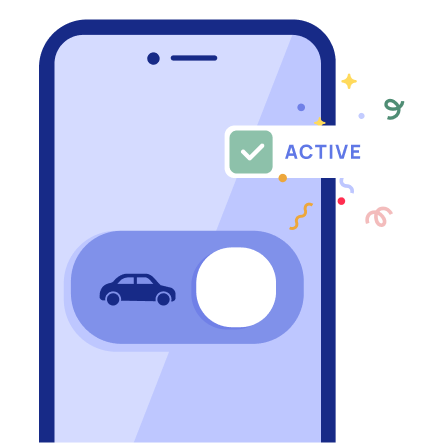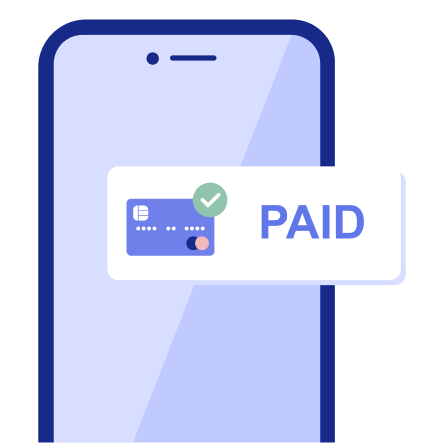How it works
Before you drive
- Enter your vehicle and payment information. Once your vehicle is activated, you are good to go!
- Remove your vehicle(s) from any previous tolling account(s).
- Remove transponder/toll tag from your vehicle.

While driving
- The tolling agency will take a picture of your license plate when driving through a toll road.
- You don’t need to have your phone with you. No equipment necessary!

After you drive
- Within 3 to 30 days after your trip, a toll charge will be posted to your account and automatically paid.
- Activate push notifications to receive payment alerts.

Watch to Learn More
Register your vehicle
All we need is your license plate number and state.
Remove your vehicle from other tolling account(s)
To ensure your tolling transactions are paid with your NextPass account, please remove your vehicle(s) from any other tolling account(s) and remove the transponder from your vehicle. Even if it is in the glove compartment or trunk, NextPass won’t work.
Drive through free flowing tolls
The tolling agency will take a picture of your license plate and notify us of your activity.
FAQs
The tolling agency will take a picture of your license plate. Once we are notified of your trip we can then charge you on your NextPass account.
Toll charges could take up to 45 days to be posted on your NextPass account from the day of the trip.
This timeframe allows for the processing and verification of toll transactions by the respective toll agencies.
Rest assured that we strive to promptly update your account with accurate toll charges.
We appreciate your patience during this period.
If you are using a toll on the list of roads where NextPass is supported, just drive through! Toll booths show a green light when a vehicle with a transponder approaches and the transponder signal is recognized. NextPass is not a transponder (or tag). With NextPass, your license plate will be recognized so you can keep driving even if the light is red.
Please advise that NextPass DOES NOT cover passing through gated toll booths such as toll roads with swing arms or gates aren’t supported.
Activating your vehicle on NextPass is a quick process that typically takes only a few seconds. After you complete your account setup and register your vehicle’s license plate , you should see an “Active” status displayed on your vehicle’s detail page. This indicates that your vehicle is ready to use NextPass for toll payments.
Once activated, you can start using NextPass immediately on supported toll roads. It’s important to ensure that you have removed your vehicle from and previous tolling accounts and removed any existing transponders/toll tags from your vehicle, as having them may interfere with the NextPass system. If you encounter any issues or do not see the active status, you may want to refresh the app or contact customer support for assistance.
No. The technology only needs to see a license plate, so once your plate is registered in the app, the state toll agency uses that to confirm your toll activity.
NextPass applies a 15% processing fee to the toll amount. This includes the pass-through fees from our payment service providers and credit card merchants.
For Virginia only, NextPass applies the processing fees charged by the state toll agencies.
NextPass is designed to work without traditional transponders or toll tags! If you have an existing transponder or toll tag on your vehicle (such as E-ZPass, SunPass, etc.), you should remove your vehicle from the previous account and remove the transponder/toll tag from your vehicle. Here’s why:
1. Interference: Having both a transponder and NextPass active can lead to conflicts in toll processing, potentially resulting in double charges or incorrect billing.
2. Account deactivation: Before using NextPass, it’s recommended that you deactivate or remove your vehicle from any existing toll accounts associated with your transponder or toll tag.
3. Removal required: To use NextPass effectively, you need to remove any existing transponders or toll tags from your vehicle. This includes removing them from the windshield, glove compartment, or trunk.
4. Clean slate: NextPass works by recognizing your license plate, so having a clean slate without other toll payment methods is crucial for accurate billing.
5. Simplified process: One of the benefits of NextPass is eliminating the need for physical transponders or tags, offering a more streamlined toll payment experience.
If you decide to switch to NextPass, make sure to properly close or adjust your existing toll account and remove all transponders or tags from your vehicle. This will ensure that your tolls are processed correctly through the NextPass system and avoid any potential billing issues or confusion.
Remember, NextPass is designed to be a standalone solution for toll payments, offering convenience without the need for additional equipment in your vehicle.
NextPass covers various types of toll roads, focusing primarily on free-flowing toll systems. Here are the key types of toll roads supported by NextPass:
1. Highway tolls: NextPass can be used to pay tolls on highways and expressways that utilize electronic tolling systems.
2. Bridge tolls: NextPass supports toll payments for bridges with electronic tolling capabilities, allowing you to conveniently pass through toll plazas without the need for cash or physical toll tags.
3. Tunnel tolls: NextPass is compatible with tunnels that use electronic toll collection systems.
4. Free-flowing toll roads: These are roads with overhead gantries that capture license plate information as vehicles pass underneath.
It’s important to note that NextPass does not support:
1. Gated toll booths: Toll roads with swing arms or gates are not compatible with NextPass.
2. Facilities that are not “open road tolling”.
NextPass is designed to work without traditional transponders or toll tags, relying instead on license plate recognition technology. This allows for a seamless toll payment experience across supported states and toll facilities. Always check the NextPass website or app for the most up-to-date information on supported toll roads and facilities in specific regions.